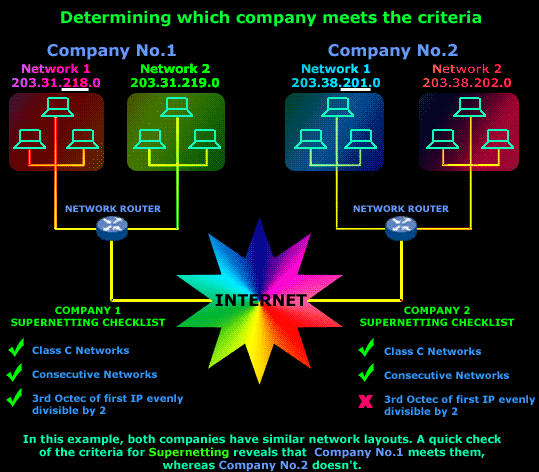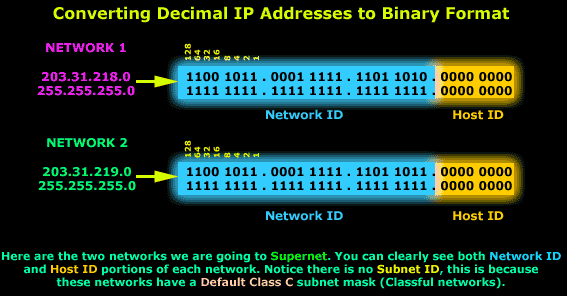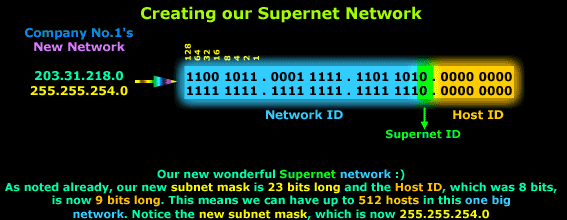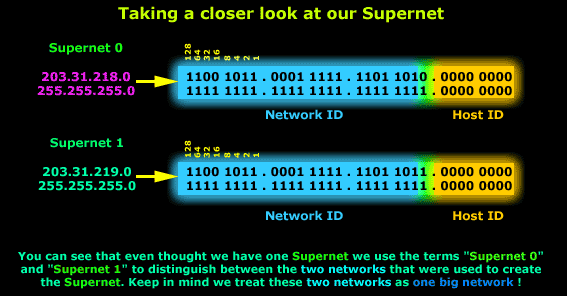Supernetting In-Depth Analysis - Learn to Identify and Create Supernets.
Our previous article served as an introduction to Supernetting, also known as Route Summarization. We covered the concept of Supernetting, how it works, its advantages and more. This article will attempt to explain how Supernetting is performed in much greater detail. We cover the various rules around Supernetting/CIDR and perform the necessary calculations to discover our supernet networks, broadcasts, IP ranges and more. We will also share our best Supernetting practices.
Article Key Topics:
It is highly advisable to read through our article What is Supernetting (Route Summarization) & How Supernets Work if you haven't already done so.
Supernetting requires solid understanding of IP, subnetting and binary notation. Read through these sections if in doubt.
Guidelines & Rules to Supernetting / CIDR
Before we get in to deep waters, we must talk about the main rule that applies to creating Supernets. For our example, this rule dictates that, in order to create Supernets from Class C IP addresses, the network address must be consecutive and the third octet of the first IP Address must be divisible by two.
If we had 8 networks we wanted to combine, then the third octet of the first IP address would need to be divisible by eight and not two.
There is one more rule you should know and this rule has to do with the routers of the network, which will need to work with the new changes. This rule dictates that all routers on the network must be running static routing or using a classless routing protocol such as RIPv2 or OSPF. Classless routing protocols include the subnet mask information and can also pass supernetting information. Routing protocols such as RIPv1 don't include subnet mask information and would certainly create major routing issues between the networks.
When attempting to calculate a subnet or supernet, it is always advisable to reference a Supernet/CIDR chart to assist with the planning and correct calculation of networks, subnets and hosts.
Supernetting Example and Analysis
Here is an example involving two companies that want to use Supernetting to solve their network requirements. We are going to determine which company mets the criteria for a Supernet (we are assuming the routers are setup in a way that will support supernetting):

The network for company 1 passes the test requirements and is therefore an eligible candidate for Supernetting.
Creating our first Supernet
Let's now take Company No.1's network, see how the Supernet will be created and determine various important parameters like the new network's broadcast address, the identification of the new supernets etc.
To begin, we must take our two networks and look at them in binary format, this is the only way to "see" exactly what we're doing when supernetting, and take a look at the Network and Host ID portions:

If you have problems understanding why we have no Subnet ID, please read up on the IP and Subnetting sections on this site where everything is explained as simply as possible using cool 3D diagrams.
Now we need to create the Supernet. This means that we are going to take one bit from the Network ID of these networks and give it to the Host ID portion. This 1bit is our Supernet ID. So our subnet mask will now be reduced from 24 bits to 23 bits. You might get confused or ask why we call this extra Bit we are giving to the Host ID a Supernet ID?
The answer is simple, the one bit that we are taking from the Network ID is given to the Host ID but, in order for us to clearly "see" where the supernet is created, we colour it green and give it the "Supernet ID" label:

So there you have it, a new supernet created!
Now we can point out something new; that we intentionally left out, in order not to confuse matters!
We have one Supernet made from two networks (203.31.218.0 and 203.31.219.0). In order to identify these two networks we name the first one (203.31.218.0) Supernet 0 and the second one (203.31.219.0) Supernet 1. This is to simply distinguish between the two networks.
It actually makes more sense if you look at the values the Supernet ID field takes:

It's very important to understand that Supernet 0 and 1 are part of the same network! This means that there is only one network address, one network broadcast address.
Let's now have a look at some more important information regarding the new network:
|
Item - Parameter
|
Value
|
|
Supernet range
|
203.31.218.0 - 203.31.219.255
|
|
Subnet Mask
|
255.255.254.0
|
|
Supernet Network Address
|
203.31.218.0
|
|
Supernet Broadcast Address
|
203.31.219.255
|
|
Supernet 0
|
203.31.218.0
|
|
Supernet 1
|
203.31.219.0
|
|
Valid IP Address range
|
203.31.218.1 - 203.31.219.254
|
|
Reserved IP Addresses
|
203.31.218.0, 203.31.219.255
|
The above table shows pretty much all the information someone would need about the new network.
It is also worth nothing that following boardcast IP addresses (based on the original network): 203.31.218.255 and 203.31.219.0 are now valid IP addresses that can be assigned to hosts.
Also, every host that will be part of this Supernet will need to be configured with the new subnet mask, 255.255.254.0 as noted in the table above. Any host that isn't reconfigured will experience network communication issues.
Summary
In this article we talked about Supernetting guidelines and rules and provided tips on how to supernet a network. We covered extensively a supernet example and calculated all necessary parameters.
Wi-Fi Key Generator
Follow Firewall.cx
Cisco Password Crack
Decrypt Cisco Type-7 Passwords on the fly!














